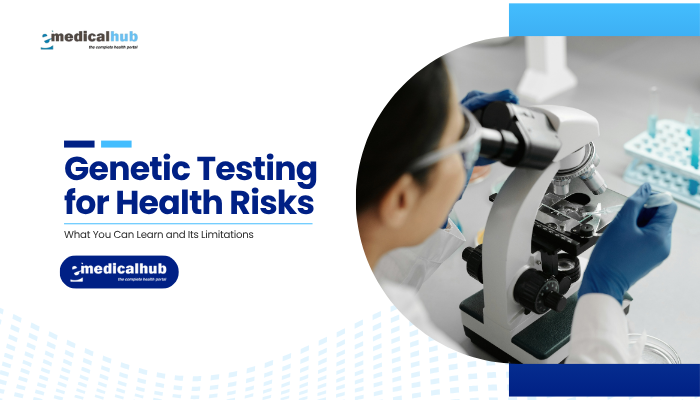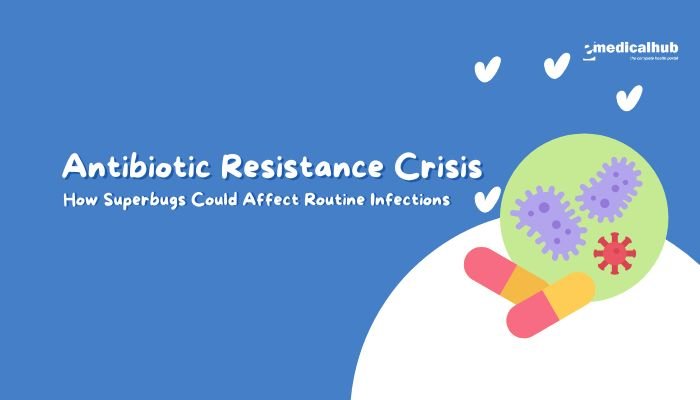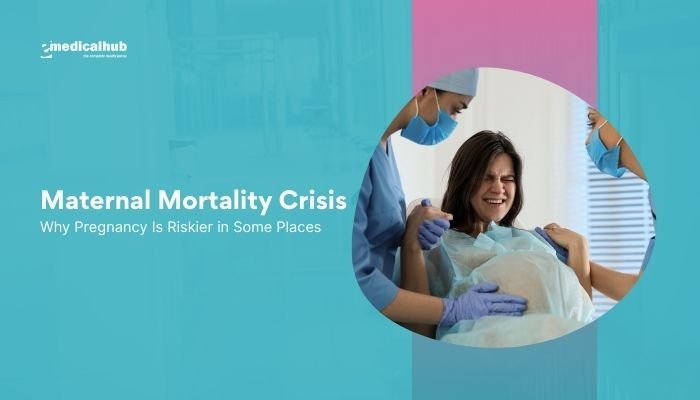Introduction
Genetic testing helps people understand parts of their DNA that may influence health risks. DNA carries instructions that tell the body how to work. In some people, small variations in these instructions can increase the chance of certain diseases.
Doctors use genetic tests to identify these variations, also known as mutations. If a test shows a relevant mutation, the person may have a higher chance of developing a specific condition such as breast cancer, hereditary heart disease, or certain metabolic problems.
Genetic testing has become more common and more affordable. Many companies offer direct-to-consumer test kits, and some healthcare facilities provide in-depth tests for serious conditions. While genetic testing can identify likely risks, it cannot predict with total accuracy if a health problem will occur.
Genes are only one part of the puzzle. Lifestyle choices, environment, and other factors play important roles in disease. This article explains the basics of genetic testing, what you can learn from it, and the limitations to keep in mind.
Understanding Genes and DNA
What Are Genes?
• Genes are made of DNA and carry the body’s instructions for building and running various systems.
• Humans have about 20,000 genes. A variation, sometimes called a mutation, can change how a specific gene works
Role of DNA
• DNA is a molecule in almost every cell, containing four chemical bases (adenine, thymine, cytosine, guanine).
• Base pairs line up in unique sequences for each person. This sequence is what genetic tests analyze.
• A single difference in sequence can cause changes in how proteins are made, which can affect health.
Genetic Inheritance
• You inherit half your genes from each parent.
• Some mutations are “dominant,” meaning you only need one copy (from one parent) for a health condition to appear or increase in risk.
• Others are “recessive,” meaning you need two copies (one from each parent) before the mutation can raise the chance of disease.
Quote: A genetics researcher once noted, “Genes load the gun, but environment pulls the trigger.” This means that having a mutation does not automatically cause an illness. Outside factors often influence if or when a disease manifests.
Types of Genetic Testing
Diagnostic Testing
• Purpose: Confirm or rule out a genetic disorder if someone has symptoms.
• Example: Testing for Huntington’s disease in a person who shows related neurological signs.
Predictive/Presymptomatic Testing
• Purpose: Identify potential risk before symptoms appear.
• Example: Checking for BRCA1 or BRCA2 mutations, which raise the risk of breast and ovarian cancer.
Carrier Testing
• Purpose: Determine if you carry a gene mutation that can affect children if both parents carry the same mutation.
• Example: Screening for cystic fibrosis (CF) gene mutations before deciding on pregnancy plans.
Pharmacogenomic Testing
• Purpose: See how a person’s genes affect their response to drugs.
• Example: Certain genetic profiles impact how people metabolize warfarin or antidepressants.
Newborn Screening
• Purpose: Test newborns for treatable conditions early.
• Example: Screening for phenylketonuria (PKU). If present, a special diet can prevent serious effects.
Direct-to-Consumer (DTC) Tests
• Offered by commercial providers.
• Often analyze ancestry, some health risk markers, or traits like lactose intolerance.
• Results can be interesting, but detailed health interpretation is limited without clinical context.
Health Risks Identified by Genetic Testing
Cancer Risks
• BRCA1/BRCA2: Variations raise the chance of breast, ovarian, and other cancers.
• Lynch Syndrome: Affects genes like MLH1 or MSH2, linked to colorectal and uterine cancers.
• Familial Adenomatous Polyposis (FAP): Leads to numerous polyps in the colon.
Cardiovascular Risks
• Familial Hypercholesterolemia (FH): Causes very high cholesterol levels, raising early heart disease risk.
• Hypertrophic Cardiomyopathy (HCM): Thickens heart muscle, can cause arrhythmias or heart failure.
• Long QT Syndrome: Extends the heart’s electrical cycle, elevating risk of dangerous arrhythmias.
Neurological Conditions
• Huntington’s Disease: Caused by repeats in the HTT gene, leading to progressive neurological decline.
• Some Forms of Parkinson’s: Linked to variants in LRRK2 or GBA genes.
• Alzheimer’s Disease: Certain mutations (e.g., APOE e4) correlate with increased risk, but not a guarantee of disease.
Metabolic and Endocrine Disorders
• MODY (Maturity-Onset Diabetes of the Young): Various genes lead to early-onset diabetes.
• Thyroid Disorders: Some forms are linked to mutations in genes that regulate thyroid hormone.
Blood and Immune System Conditions
• Sickle Cell Disease: A recessive mutation in the HBB gene.
• Thalassemias: Affect hemoglobin production, causing anemia.
• Hereditary Hemochromatosis: Excess iron buildup, leading to organ damage over time.
Carrier States
• Cystic Fibrosis (CF): Carriers usually have no symptoms but can pass the mutation to children.
• Spinal Muscular Atrophy (SMA): Caused by SMN1 gene deletions.
• Tay-Sachs Disease: More common in certain populations, leads to severe neurological issues if both parents are carriers.
How Genetic Testing Works: Steps in the Process
Pre-Test Counseling
• Many hospitals recommend speaking with a genetics counselor.
• The counselor explains reasons to test, possible outcomes, and how results may affect personal and family health.
• This is the time to discuss ethical, emotional, or insurance questions.
Sample Collection
• Blood Draw: Common for clinical tests.
• Saliva or Cheek Swab: Common for direct-to-consumer tests.
• Amniocentesis or Chorionic Villus Sampling (CVS): For prenatal testing.
Laboratory Analysis
• DNA Extraction: Lab technicians isolate DNA from cells in the sample.
• Targeted Testing vs. Whole Genome/Exome Sequencing: Targeted testing looks at specific genes, while broader tests evaluate thousands of genes at once.
• Variant Identification: The lab looks for known disease-causing variants or unknown variations that may have an impact.
Data Interpretation
• Pathogenic Variant: Known to contribute to disease.
• Likely Pathogenic: Strong evidence suggests disease association, but not fully confirmed.
• Variant of Unknown Significance (VUS): Unclear if it causes disease.
• Likely Benign or Benign: Unlikely to cause disease.
Results Discussion
• A genetics counselor or doctor interprets the findings.
• They may suggest additional tests, lifestyle changes, or risk-reduction measures.
• Emotional support is essential, especially for serious findings.
Test Results: Positive, Negative, and Variants
Positive Result
• The lab found a mutation linked to a disease or condition.
• This may change medical management. For example, women with a BRCA mutation often discuss increased screening or preventive measures such as prophylactic surgery.
• Emotional impact can be significant. Some people experience fear or anxiety about future illness.
Negative Result
• No known harmful variants are found for the tested genes.
• This does not remove all risk, since not all genes or mutations are tested, and other non-genetic factors may play a role.
• A negative result can be reassuring but should be understood in the context of family and personal health histories.
Variants of Unknown Significance (VUS)
• The test uncovers a genetic change not fully understood by science.
• As data accumulates, labs may later update the classification to benign or pathogenic.
• Further family testing or research may help clarify the variant’s importance.
Quote: A genetic counselor commented, “We sometimes compare a VUS result to finding an unfamiliar word in a new language. It exists, but we do not fully know its meaning yet.”
Genetic Counseling and Support
Role of Genetic Counselors
• Explain testing options, benefits, and limits.
• Assess personal and family history to estimate disease risks.
• Help interpret results and advise on next steps.
• Provide emotional support during decision-making.
Discussing Results with Family Members
• Some results have family implications. Siblings, children, or other relatives might carry the same mutation.
• Sharing information can help loved ones decide if they want testing.
• Respect privacy concerns—some family members may not want to know.
Psychosocial Factors
• Positive results can lead to anxiety or guilt about passing mutations to children.
• Counseling helps people handle emotions and avoid panic or confusion.
• Health professionals can connect individuals to support groups if needed.
Limitations and Considerations
Not a Crystal Ball
• Genes alone cannot predict exact outcomes.
• Lifestyle elements (e.g., diet, exercise, smoking) and environmental exposures strongly affect health.
• Low-penetrance variants raise risk slightly but do not guarantee disease.
Complex Diseases
• Many common conditions—such as type 2 diabetes, hypertension, or mental health disorders—arise from multiple genes plus other factors.
• A single test cannot capture all the influences.
Possible False Reassurance
• A negative test for a common mutation does not eliminate the possibility of a rare or untested variant.
• Screening protocols (like mammograms or colonoscopies) may still be recommended based on age or family background.
Test Interpretation Challenges
• Labs differ in their classification methods. One might label a variant as likely pathogenic, another as VUS.
• Re-testing or second opinions may be useful if results are unclear or if guidelines change.
Emotional and Ethical Questions
• A gene variant might indicate a serious disease that lacks a cure. Some individuals might prefer not to know.
• Pre-symptomatic testing for adult-onset diseases can raise concerns about how this knowledge affects a person’s outlook on life.
Possible Insurance Implications
• Some countries have laws preventing discrimination based on genetic information, but insurance policies vary.
• Individuals should investigate local regulations and potential impacts on health, life, or disability insurance.
Table: Common Benefits and Drawbacks of Genetic Testing
| Aspect | Benefits | Drawbacks |
| Knowledge of Risk | Helps guide medical decisions | May cause anxiety if risk is high |
| Early Detection | Screening schedules can be adjusted | Not all diseases are preventable or well-managed |
| Family Planning | Carrier status can inform pregnancy decisions | Family members may not want to know |
| Treatment Tailoring | Pharmacogenomic tests improve medication use | Some conditions lack clear treatment protocols |
| Peace of Mind | Negative results can relieve uncertainty | False reassurance if tests do not cover all variants |
| Privacy Concerns | Informed decisions on data sharing | Insurance or job discrimination in some regions |
Privacy, Security, and Discrimination
Data Security
• Genetic data is personal health information. Labs must store it securely.
• Some direct-to-consumer companies share anonymized data for research or profit, but policies differ.
• People need to check each company’s privacy terms carefully.
Genetic Information Nondiscrimination
• Some places have laws that prohibit health insurance or employers from using genetic data in discriminatory ways.
• Life insurance, long-term care, and disability coverage may not be covered by these laws.
Family Dynamics
• Results can reveal paternity questions or other sensitive family information.
• Genetic testing can uncover half-siblings or other unexpected relatives if data is used in genealogical databases.
Future Directions of Genetic Testing
Whole Genome Sequencing (WGS) and Whole Exome Sequencing (WES)
• Instead of focusing on a few genes, labs can read most or all of a person’s DNA.
• This approach can reveal unknown mutations related to rare diseases.
• Challenges include large amounts of data, uncertain findings, and cost.
Polygenic Risk Scores
• Researchers combine many common gene variants into a single score that suggests risk levels for conditions such as heart disease or diabetes.
• Not yet a standard clinical tool, but may become more useful.
CRISPR and Gene Editing
• Emerging technology that allows scientists to edit genes.
• Potential for curing certain genetic disorders in the future.
• Ethical and safety concerns remain.
AI and Machine Learning in Genetics
• Algorithms can spot new gene-disease links, improving variant interpretation.
• Could enhance test accuracy and reduce the time it takes to classify unknown variants.
Deciding If Genetic Testing Is Right for You
Personal and Family History
• If multiple family members have the same disease, a genetic test may clarify if there is an inherited mutation.
• Some conditions are more common in specific ethnic or geographic groups.
Emotional Readiness
• Consider whether you are prepared for potentially serious information about your health future.
• Think about how you would handle risk-reducing measures or lifestyle changes after learning results.
Impact on Medical Decisions
• Positive results might mean more aggressive screening (e.g., more frequent mammograms).
• Negative results could reduce unneeded procedures in families.
• Carrier status might affect family planning.
Cost and Insurance Coverage
• Some tests are covered by insurance if a family history strongly suggests genetic disease.
• Direct-to-consumer tests usually require out-of-pocket payments.
• Prices vary widely, from a few hundred to several thousand dollars.
Genetic Counseling Advice
• A professional can walk you through benefits, limits, and ethical aspects.
• They also offer support in interpreting results and deciding on next steps.
Practical Tips for Those Considering Genetic Testing
Ask About Specific Genes and Conditions
• Understand exactly which genes the test reviews.A panel for hereditary cancer might check BRCA1, BRCA2, and other genes related to colon or stomach cancer.
• Broader tests (e.g., exome sequencing) can find unexpected variants.
Check Credentials and Certification
• If you choose a direct-to-consumer service, verify its lab accreditation.
• Clinical-grade labs follow strict standards for accuracy.
Review Privacy Policies
• Who owns your genetic data?
• Is there an option to opt out of research data sharing?
• How long is your sample or data stored?
Prepare for Possible Outcomes
• Positive: Be ready to consider frequent screenings, lifestyle changes, or even preventive surgery.
• Negative: Understand that a negative result does not rule out all risk.
• VUS: You may have to wait for more research.
Seek Counseling
• Professional guidance can reduce confusion or anxiety.
• Counselors help manage results that carry significant life implications.
Confirm Results with a Healthcare Provider
• If a consumer test suggests a serious variant, consult a medical professional for confirmation.
• This often involves re-testing through a clinical lab.
Case Examples
BRCA1 Mutation in a Family History of Breast Cancer
Sarah has two aunts and one cousin who had breast cancer before age 50. Her doctor suggests a BRCA test. When her result is positive, Sarah meets with a genetic counselor to discuss increased breast screenings, medication options, and prophylactic mastectomy. She decides on a plan involving more frequent screenings and a discussion about preventive surgery.
Cardiomyopathy Screening
Michael’s father died of heart failure at age 45, and tests later revealed a hypertrophic cardiomyopathy gene. Michael undergoes genetic testing in his 20s. He tests positive, enabling close monitoring and early medical therapy to control symptoms. He also informs his siblings so they can decide if they want testing.
Carrier Testing for Cystic Fibrosis
Brian and Kate are planning a family. They learn about carrier testing through their prenatal clinic. Both discover they carry the same CF mutation. They speak with a genetic counselor about reproductive options, such as in-vitro fertilization with genetic screening or preparing for the possibility of having a child with CF.
Emotional and Social Aspects
Genetic Discrimination Fears
• Some fear stigma if employers or insurers learn about high-risk genes.
• Laws can reduce such discrimination, but uncertainty can remain.
Family Interactions
• Relatives might react differently to shared genetic risk information.
• Some become anxious or blame each other. Others find it helpful to plan health strategies together.
Community and Cultural Beliefs
• Certain cultural or religious groups have specific views on genetic testing, particularly regarding prenatal screening.
• Sensitivity and respect for diverse perspectives are important.
Mental Health Support
• People who learn they carry a high-risk mutation may struggle with stress or guilt.
• Mental health professionals can offer coping strategies and counseling.
Future of Genetic Screening in Preventive Health
Preventive Medicine Trends
• As more genes are linked to diseases, screening could become a routine part of adult health care.
• Personalized health plans may include targeted nutrition, exercise, and medication based on genetic profiles.
Combined Biomarker Approaches
• Some clinics already combine genetic data with imaging or blood tests to refine cancer screening or cardiovascular checks.
• Multi-modal systems might yield earlier, more accurate risk detection.
Pharmacogenetics in Everyday Care
• Testing for drug metabolism genes could become standard before prescribing certain medications.
• This approach aims to reduce side effects and improve outcomes.
Expansion of Accessibility
• Lower costs and improved technology are making tests more available worldwide.
• Training more genetic counselors and educating primary care physicians is crucial for proper interpretation.
Conclusion
Genetic testing offers insights into health risks that were difficult to detect in the past. It can guide preventive measures, influence family planning, and shape medication choices. While testing can reveal important details, it does not provide full certainty about future illness. Environment, lifestyle, and random factors also play roles in health outcomes. Test findings should be reviewed with genetic counselors or experienced healthcare providers who can explain results in the context of personal and family history.
Individuals should weigh the pros and cons before proceeding. A positive result might lead to better prevention or early treatment, but it can also bring stress and important decisions. A negative result can offer reassurance but does not eliminate all disease possibility. Variants of unknown significance require patience and continued research. Taking these factors into account, genetic testing can be a valuable tool in modern healthcare when approached with care, knowledge, and support.
References
- Wilson K, Coyle W. Genetic testing in clinical practice: benefits, limitations, and ethical issues. J Med Genet. 2020;57(8):535-542.
- Roberts D, Lee S. An overview of direct-to-consumer genetic testing. Mol Diagn Ther. 2021;25(1):65-72.
- Stark Z, Dolman L. Integrating genomic sequencing into pediatric care. Genet Med. 2019;21(11):2532-2540.
- Richards CS, Bale S, Grody WW. ACMG recommendations for standards in genetic testing. Genet Med. 2019;21(3):635-645.
- Offit K, Bradbury A. Clinical cancer genetics: risk counseling and management. CA Cancer J Clin. 2021;71(1):45-63.
- Ormond KE. Genetic counseling: ethical and psychological considerations. Annu Rev Genomics Hum Genet. 2020;21(1):193-213.
- Lu JT, Kassab K. Cardiovascular genetics: a focus on familial cardiomyopathies. Circulation. 2021;143(7):673-685.
- Fridovich-Keil J, DeCristo D. The expanding role of pharmacogenomics. Clin Pharmacol Ther. 2018;104(4):679-681.
- Green RC, Berg JS. Updated classification of genetic variants: an ongoing effort. Hum Mutat. 2021;42(3):258-266.
- Manickam K, McClain MR. Comprehensive genetic testing for adult-onset diseases: results from large-scale screening. Nat Med. 2020;26(8):1235-1242.
- Torkamani A, Andersen KG. Transforming the practice of precision medicine with polygenic risk scores. Nat Rev Genet. 2021;22(9):572-588.
- Grosse SD, Khoury MJ. The future of newborn screening in the genomic era. Nat Rev Genet. 2021;22(7):535-544.







